How a Public Art Program Transformed Qatar’s Capital City Into a Blue-Chip Sculpture Park

Urs Fischer’s Lamp Bear at Hamad International Airport.
Once the vast oil and gas reserves of Qatar were discovered in the mid-20th century, Doha, its capital, was transformed rather quickly. Formerly a village on the edge of the desert known for pearl fishing and trading, it’s now a cosmopolitan metropolis with soaring skyscrapers and Gulliver-sized institutions designed by starchitects, including I. M. Pei, Jean Nouvel, Arata Isozaki and Rem Koolhaas. And installed at many of their sites, as well as the airport, parks and other publicly accessible places, you’ll find noteworthy sculptures by the likes of Richard Serra, Louise Bourgeois, Urs Fischer, Damien Hirst, César and Eduardo Chillida.
You can probably name other cities peppered with buildings designed by Pritzker Prize–winning architects and their colleagues, past and present. As for public sculpture, it, too, is not that unusual a sight in plazas and piazzas around the world. But the ubiquity of three-dimensional art in Doha and its environs has transformed this country on the Gulf of Arabia, which gained its independence from the British in 1971, into a remarkable sculpture park. Works in bronze, steel and wood also redefine the nature of the buildings they adorn.
Related stories
Sold! French Billionaire Patrick Drahi Just Bought Sotheby's for $3.7 Billion
'We Are Trying to Create Energy Centers': Hauser & Wirth's Marc Payot on Redefining the Art Gallery
14 Big Ideas That Are Changing Luxury Lifestyle Right Now
Take Hamad International Airport, which annually accommodates about 50 million travelers. It’s chockablock with all sorts of sculptures—essentially a museum that caters to sophisticated adults as well as rambunctious children. Urs Fischer’s Lamp Bear (2005/06), located where all the concourses converge, steps away from duty free shopping, is emblematic of the curatorial approach. It’s difficult not to crack a smile as you walk past this 23-foot-tall, 20-ton work, which is elevated on a circular pedestal specifically designed by the artist for its present location. If you’re a New Yorker, you may recognize this yellow cub from its five-month sojourn in 2011 in front of the Seagram building. When it was dwarfed by Mies van der Rohe’s elegant tower, there was nothing ingratiating about it. In Doha, though, its scale is everything. Lamp Bear currently commands its surroundings, more than holding its own as multitudes move around it. Since Fischer’s bronze sculpture resembles a stuffed animal gifted on Christmas, some kids might believe it was purchased at F.A.O. Schwartz rather than at a Christie’s evening sale in 2011 for $6.8 million dollars.
Along one concourse, you’ll find an eight-part playground designed by Tom Otterness. Parents must be grateful that their children, before boarding flights home, can tire themselves out climbing all over its spread-out elements or slithering down one of its slides. A section of this amusement park on West 43rd Street near the Hudson River in New York attracts far fewer boys and girls. In Doha, one evening around midnight, Tom Otterness was delighted to hear the sounds of kids screaming while playing on his bronze behemoths. “That’s not typical,” the artist recently told me, of youngsters enjoying themselves so late at night. He was enthralled by both “the scale of the project and its having a 24-hour, day-and-night schedule.”
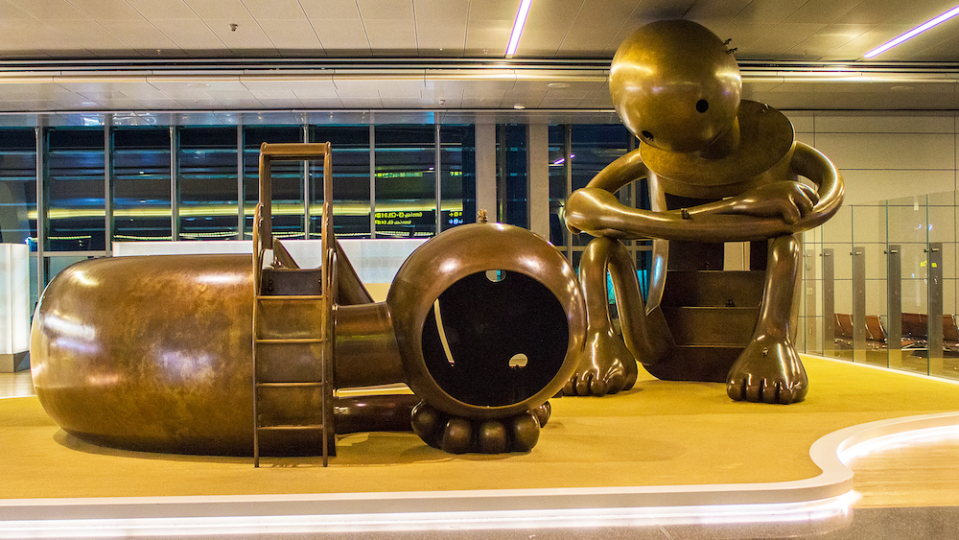
Sculptures by Tom Otterness at Hamad International Airport.
All told, there are about two dozen striking sculptures created by international, regional and local artists at the airport. These include KAWS’s Small Lie, a 32-foot-tall, 15-ton version of one of his characters, whose title and form refer to Pinocchio; a herd of bronze oryx, an antelope species indigenous to the Gulf region, by Tom Claassen, a Dutchman; Marc Quinn’s tall bronze, white patinated Arctic Nurseries of El Dorado (2008); and other works by Adel Abdessemed, Rudolf Stingel, Jean-Michel Othoniel and Dia Azzawi. Some are installed in the arrivals hall; others are located near check-in counters as well as departure gates.
In Qatar, you can regularly expect to drive past a monumental sculpture that will make you want to get off the road at the next exit and double back to see the art close-up. In front of Sidra Medical and Research Center, a hospital serving women and children, there’s a series of 14 giant-sized bronzes by Damien Hirst that graphically represent The Miraculous Journey (2005–13). Ranging in height from roughly 16 to 36 feet, Hirst has depicted an egg fertilized by sperm, wombs representing the nine-month gestation of a fetus and finally, a newborn baby boy. Only Hirst would have had the gumption to create this ensemble, which took three years to complete. Downplaying the audacity of the display, Sheikha al-Mayassa Hamad bin Khalifa al-Thani, founder and chair of the Qatar Museums Authority, told the New York Times in 2013, “There is a verse in the Koran about the miracle of birth. [Hirst’s interpretation] is not against our culture or our religion.” Nevertheless, even some Westerners might find this multi-part work a shock to decorum.
Nearby, the Qatar National Convention Center, designed by Arata Isozaki, also grabs the attention of drivers and passengers whizzing past thanks to its enormous façade incorporating actual tree trunks. Inside, one of Louise Bourgeois’s Maman spiders towers above visitors. Jerry Gorovoy, Bourgeois’s longtime assistant and head of her foundation, finds that this site grants “a seriousness to the spider, which is a portrait of the artist’s mother.” In the evening, when the marble-lined entrance hall is brightly lit, the bronze arachnid, visible from both sides of the road, comes alive. It truly rules the night.
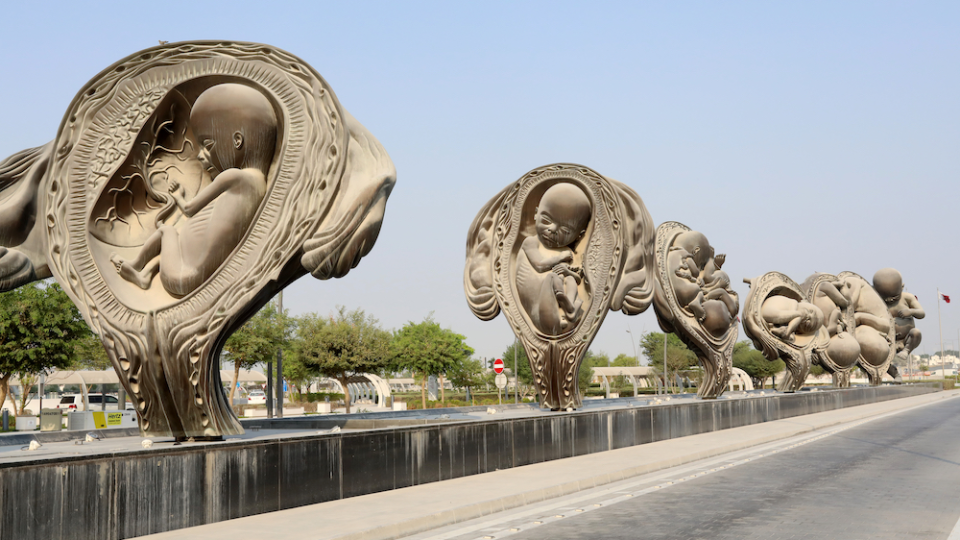
Damien Hirst’s The Miraculous Journey.
Then, there’s Tony Smith’s 24-foot-tall Smoke (1967), located in front of another convention center in the West Bay area of Doha. Another edition of this multi-faceted steel piece has been squeezed into an interior court at the Los Angeles County Museum of Art. Placed outside in Qatar, it is reflected in the center’s glazed facade while adjacent palm trees provide a sense of scale so that the work is not overwhelmed by the supersized building. When it’s illuminated in the evening, Smoke actually resembles rising vaporous flumes.
For a number of years, 7 (2011) was the most famous Richard Serra in Qatar. I. M. Pei recommended that Serra be commissioned to create a work that would be located near his resplendent Museum of Islamic Art, which opened in 2008 on a manmade island in the city’s harbor. Serra’s 80-foot-tall, site-specific sculpture was then installed on a site specifically constructed for it. (It took three years to extend the existing esplanade 250-feet and then reinforce it.) A Qatari website recommends standing inside the work, which is comprised of seven soaring, somewhat narrow Cor-Ten steel plates, and looking up toward the sky. Unfortunately, during the ongoing blockade of the country by other countries in the region, security guards are stationed inside 7, prohibiting you from walking into it or taking photographs.
The piece recalls several other Serra works, including Carnegie in Pittsburgh, which co-won first prize at the 1985 Carnegie International, but the artist has said that he conducted extensive research to execute 7, studying minarets from Spain to Yemen and learning about one from the 10th century that was planar. “I thought I could use my vocabulary and dovetail into the vocabulary of the Afghan minaret quite easily,” he told an interviewer in 2011.
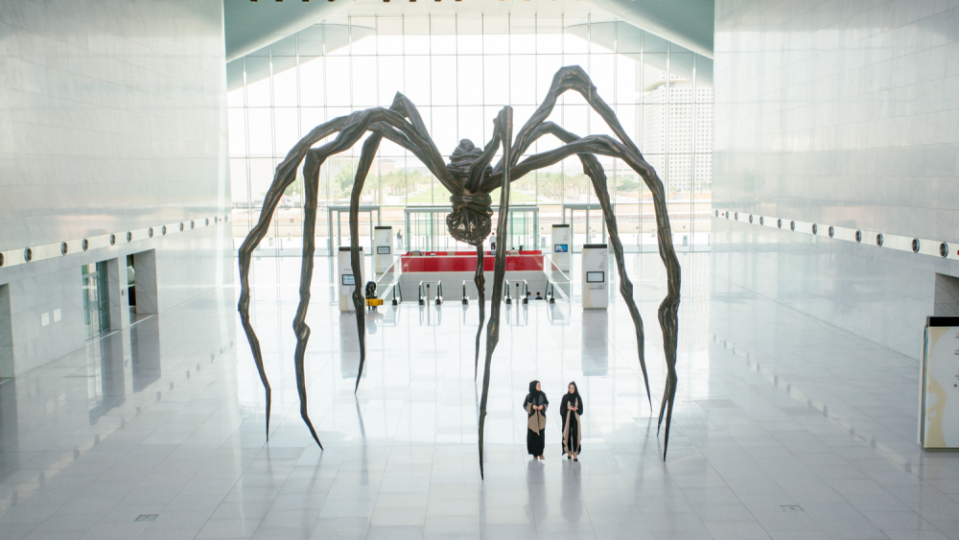
Louise Bourgeois’s Maman at the National Convention Center.
Five years ago, Serra gave new meaning to the term “destination sculpture.” In the desert, about 56 miles from Doha (a distance the length of Rhode Island), the then-74-year-old artist installed East-West/West-East. One of the great sculpture groups of our time, it’s comprised of four Cor-Ten plates just a few inches taller and shorter than 50 feet, with its two pairs separated by about a half-mile. It is located in the Brouq Nature Reserve, where herds of oryx once gathered. Now, caravans of SUVs bring art aficionados from Doha to see this astonishing example of Land Art.
Like 7, East-West/West-East is a variant of earlier works by Serra. But, once again, the core idea has been dramatically enlarged. To the left and right of the tall metal plates, there are two distinctive gypsum plateaus “shaped,” in the artist’s own words, “like oversize mushrooms.” The steel elements were sunk into the sandy ground so that their tops are level with the heights of the chalky mounds: one set is slightly taller than 54 feet; the other, just above 48 feet. Serra found working in “that vast a space” to be “very humbling.” Visitors to this awesome sculpture have lots to absorb, especially if they’re caught in a sandstorm. If you’re with a group of people and look from one end to the other, your friends and colleagues off in the distance next to the steel planks may look like ants. Unless you’ve been there, the scale is practically unimaginable. If the contemporary art world had seven wonders, this would be one of them.
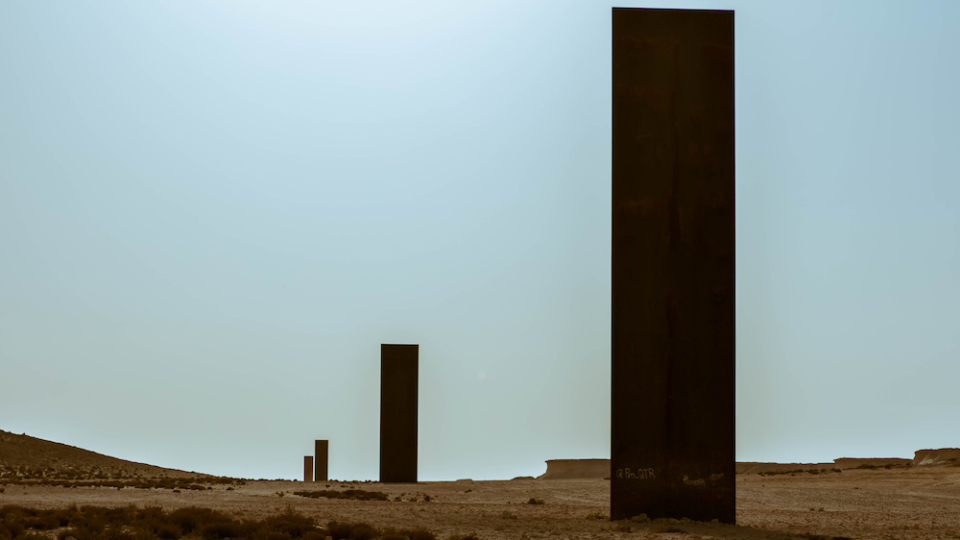
Richard Serra’s East-West West-East.
Many of the sculptures by Western artists in Qatar are already tried and true. For example, Tony Smith’s Smoke appeared on the cover of Time magazine in 1967. Then, there’s the original steel version of Bourgeois’s Maman, which was installed in Tate Modern’s humongous Turbine Hall when the museum was inaugurated in 2000; and subsequently, spiders belonging to the bronze edition have been placed outdoors by the Guggenheim Bilbao, the National Gallery of Canada in Ottawa, the Mori Art Center in Tokyo, Crystal Bridges in Bentonville, Arkansas and elsewhere. Sent to Doha from the Yorkshire Sculpture Park, KAWS’s Little Lie is another piece that’s been on view in a different context. For the most part, though, these works look better in Qatar. Sculptures once seen outside are now viewed indoors, and vice-versa. The shifts work spectacularly—they’re perfectly sited in Doha.
While several soccer stadiums are currently under construction for the 2022 World Cup—amid allegations from international observers that workers’ human rights have been being violated—no one is saying whether artworks will adorn these new structures.
The royal family of Qatar doesn’t mind sitting on information because they committed to their art projects for the long haul. (Both the Emir and his sister, the Sheika, are only in their late 30s.) Work on a museum of modern art has been delayed until after the World Cup, but eventually a grain mill is going to be transformed for the display of art dating from Corot to the present. Countless paintings, sculptures and videos already have been purchased from auction houses, foundations and dealers, who are staying mum regarding the details.
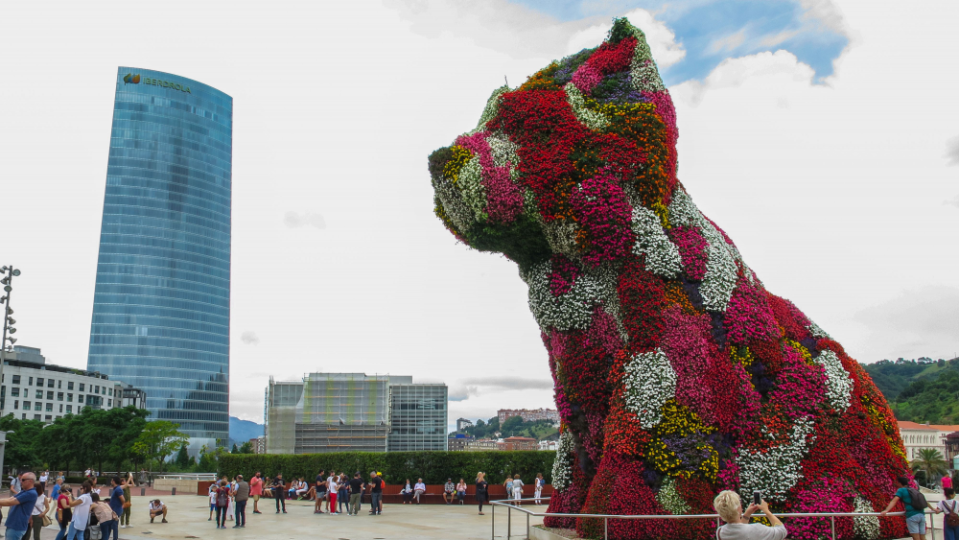
Jeff Koons’ Puppy, a Qatari loan.
Until then, the public sculptures on view in Doha reveal much about Qatar’s collecting practices. For one, price is no object. Nor is size an issue. But beyond those practicalities, the works have an intriguing thematic unity. Look again at Urs Fischer’s Lamp/Bear, the caricature-like characters of Tom Otterness’s playground, Louise Bourgeois’s Maman and KAWS’s Small Lie, not to mention Jeff Koons’s plant covered Puppy, which was identified as a Qatari loan when it was exhibited years ago in Australia (though it’s never been on view in Doha), and some Murakami works that ARTnews has identified as being owned by the Qataris. Note the yearning for childhood regained. In this Gulf country, Peter Pan-like three-dimensional art is juxtaposed with futuristic architecture. At a dire moment in world history, a group of sculptures has been brought together that look back to more innocent times.
Sign up for Robb Report's Newsletter. For the latest news, follow us on Facebook, Twitter, and Instagram.

